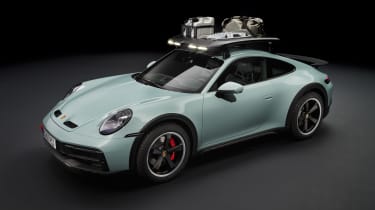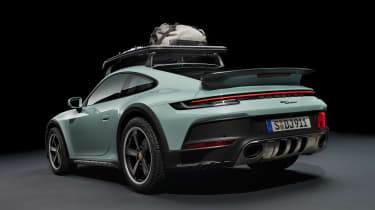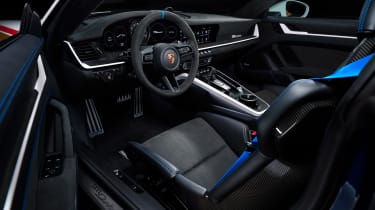Limited to just 2,500 examples, the new Porsche 911 Dakar comes with power from the 911 GTS and useful levels of ground clearance
In 2002, Porsche launched the first-generation Cayenne SUV – a landmark moment for the Stuttgart sports car maker that transformed the brand’s fortunes, returning huge profits. Purists were critical, doubly so when the Cayenne spawned a smaller and equally money-making sibling in the form of the Macan.
But the cash generated by these big selling models has always ensured a steady flow of investment into what has become an increasingly diverse 911 line-up. Perhaps, then, there’s a strong degree of irony to this new model, made possible by the profits generated by the brand’s SUVs. It’s called the Porsche 911 Dakar, and as the name – and its looks – suggest, it’s a 911 developed for off-road use.
New Porsche 911 GTS 2021 review
The 911 Dakar will be limited to 2,500 units, and orders are now open, with it costing from £173,000 in the UK. Only the 911 GT3 RS, Turbo S Cabriolet and Sport Classic come in at a higher price. And it’s not the only high-riding take on a well-known performance car we’ll see this year – Lamborghini will take the niche format to supercar levels of performance, when it fully reveals the new Huracan Sterrato.
The car takes inspiration from the victory scored by the Porsche 953 in the 1984 Paris-Dakar rally. And as per the legend created by that car, the 911 Dakar is available with an optional package called the Rally Design Package, equipping the new 911 with a tribute livery.
The source of power is familiar, being the same twin-turbocharged 3.0-litre flat six used in the 911 GTS. It develops 473bhp and 570Nm of torque, sending power to all four wheels via an eight-speed PDK transmission. All together, it’s capable of propelling the off-road ready 911 Dakar from 0-62mph in just 3.5 seconds.
But what really makes the 911 Dakar stand out is its new stance, created via a combination of bespoke bodywork and a significantly raised ride height brought about by newly developed suspension technology.
Its standard ride-height is 50mm higher than that of a 911 Carrera S on sports suspension, but it can be raised by a further 30mm thanks to a four-corner lift system, which the brand claims enables the 911 Dakar to take part in “ambitious off-road adventures.”
The car has been extensively developed off-road, on dirt tracks, desert dunes, snow and ice, as well as on loose surfaces, and the standard fit all-terrain tyres wrapped around 19-inch wheels at the front, and 20-inch items at the rear are more than a nod to this new capability. However, they do mean that Porsche has felt it necessary to electronically limit the top speed of the 911 Dakar to 149mph (106mph in the fully-raised suspension mode).
In anticipation of the rougher, more physically demanding surfaces the 911 Dakar has been tasked with dispatching, it leverages the dynamic engine mounts of the GT3 model, providing a flexible and responsive level of rigidity. It also comes with rear-axle steering and Porsche Dynamic Chassis Control anti-roll stabilisation.
Along with this existing technology, Porsche engineers have developed two bespoke drive modes for the Dakar. Rally mode is claimed to be a setup idea for loose, rally-stage like surfaces, delivering a rear-biased all-wheel-drive programme. Offroad mode is specifically for maximum 4×4 capability and clearance. Both of these modes feature a new Rally Launch Control system, too.
The 911 Dakar’s body kit uses carbon-fibre reinforced plastic panels to keep the car’s weight down. At 1,605kg, it’s 10kg heavier than a Carrera 4 GTS with a PDK gearbox. The bonnet is taken from the 911 GT3, but the fixed rear wing is new, as are the wider wheel-arches, the chunky side sills, and the new front and rear bumpers complete with additional underfloor protection and stainless steel protected front grilles.
Other off-road touches include towing lugs front and rear, while the car will also be offered with an optional roof-rack with a 42kg capacity, LED lighting and a 12-volt power outlet. A roof tent option has also been developed.
The 911 Dakar is a strict two-seater, with a roll cage taking the place of the rear bench. Up front, two full-size bucket seats are equipped, while the cabin is lightly trimmed with Race-Tex surface with green stitching. Treadplates and a dashboard emblazoned with the 911 Dakar badge complete the interior makeover. The car will arrive on UK roads next spring.
What do you think of the new Porsche 911 Dakar? Let us know your thoughts in the comments section…
Source: Read Full Article


 New Porsche 911 GTS 2021 review
New Porsche 911 GTS 2021 review
